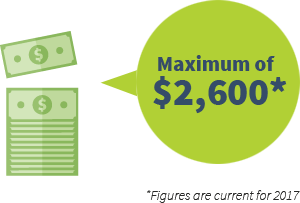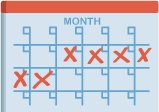A smart way to maximize your savings
If you’re enrolled in a qualified high-deductible health plan (HDHP) and have a Health Savings Account (HSA), you can maximize your savings with a Kazdon HSA-Compatible Flexible Spending Account (FSA). This pre-tax benefit account helps you save on this plan year’s eligible out-of- pocket dental and vision expenses while taking advantage of the long-term savings power of an HSA.

Why enroll in a Kazdon HSA-Compatible FSA?
Maximize your tax savings with both an HSA and a Healthcare.
Save an average of 30% on this year’s eligible out-of- pocket dental and vision expenses while using your HSA to save for future healthcare expenses
Use a single smart payment card to access funds in both accounts
Savings with Your HSA-Compatible FSA
A Healthcare FSA lets you pay for qualified out-of- pocket healthcare expenses on a pre-tax basis. The money you contribute to a Healthcare FSA is not subject to payroll taxes, so you end up paying less in taxes and taking home more of your paycheck.
Your Estimated Tax Savings
Without HSA-Compatible FSA
Gross Annual Pay (Estimate) $60,000
Annual Family Coverage HSA Contribution -$6,650
Adjusted Gross Pay =$53,350
Tax Rate (30%) -$16,005
Annual Dental/Vision Care Expenses -$2,600
Final Take Home Pay =$34,745
All figures in this table are estimates and based on an annual salary of $60,000 and maximum contribution limits to the benefit account. Your salary, tax rate, healthcare expenses, and tax savings may be different.
With HSA-Compatible FSA
Gross Annual Pay (Estimate) $60,000
Max. Annual HSA-Compatible FSA Contribution -$2,600
Max. Annual Family Coverage HSA Contribution -$6,650
Adjusted Gross Pay =$50,750
Tax Rate (30%) -$15,225
Final Take-Home Pay =$35,525
Take Home This Much More ! $780
Why enroll in a Kazdon HSA-Compatible FSA?
An HSA-Compatible FSA is a great way to maximize your savings this year and in the future. But there are rules guiding your participation in this account.
An HSA-Compatible FSA is right for you if:
*Figures are current for 2021
You have a qualifying high-deductible health plan with an annual deductible of at least $1,400 for individual coverage and $2,800 for family coverage*
You qualify for an HSA and set up an HSA
Contributing to Your HSA-Compatible FSA
The IRS sets the annual contribution limits. A different limit may apply to you according to your employer’s plan.
You may convert your HSA-Compatible FSA to a traditional Healthcare FSA after you have met your minimal annual HDHP deductible of $1,400 for individual coverage and $2,800 for family coverage.*

Enrolling in Your HSA-Compatible FSA

You enroll in or renew your election in your HSA-Compatible FSA through your employer during your Open Enrollment period. Your human resources department or benefits administrator can tell you when employees in your organization can enroll in an HSA-Compatible FSA and help you get started.
Estimating Contributions to Your HSA-Compatible FSA
 An HSA-Compatible FSA is an annual account. As a rule, the money you contribute to your HSA-Compatible FSA must be used within the plan year.
An HSA-Compatible FSA is an annual account. As a rule, the money you contribute to your HSA-Compatible FSA must be used within the plan year.
That’s why it’s important to estimate how much you spend on eligible dental and vision care expenses for you and your eligible dependents each year before you decide how much to contribute to your HSA-Compatible FSA.
Use this calculator to estimate your annual eligible expenses and determine an annual HSA-Compatible FSA election amount that’s right for you and your family.
Avoiding “Use It or Lose It” with Your HSA-Compatible FSA
Nervous about enrolling in an HSA-Compatible FSA because you’re afraid of losing money left unspent in your account at the end of your plan year? Don’t be!
While it’s always important to choose your annual election amount carefully (this calculator can help), the “use it or lose it” rule no longer applies to all types of HSA-Compatible FSAs.
What happens to money left unspent in your account at the end of a plan year depends on the type of HSA-Compatible FSA your employer has chosen for its employees.
Depending on your employer’s plan, you may:
- Carry over up to allowed annual IRS carry over limit left in your account from one plan year to the next
- Have a grace period of up to 2½ months after your plan year ends during which you can spend down money left in your account
- Forfeit any money left unspent in your account at the end of your plan year to your employee.
Check with your employer to find out which type of Healthcare FSA you have:
- Healthcare FSA with Carryover
- Healthcare FSA with Grace Period
- Standard Healthcare FSA
Changing Your HSA-Compatible FSA During the Year
You should plan on an election amount to your HSA-Compatible FSA that meets your needs for the entire plan year. As a rule, you can’t change your HSA-Compatible FSA election amount during your plan year.
But there are limited circumstances when you can make changes. For example, if you experience what’s called a Qualifying Life Event, like a marriage or a birth, you may change your HSA- Compatible FSA election amount mid-year.
It’s important to note that if you leave your job, any money left unspent in your HSA-Compatible FSA stays with your employer. You can’t take your HSA-Compatible FSA with you if you leave your company. But if you quit or are terminated from your job and you still have money left in your account, you may elect COBRA to continue your HSA-Compatible FSA through the end of your plan year.
It’s also important to note that the money in your HSA is yours to keep, even if you change jobs, switch healthcare plans, or retire. If you lose your job and elect to retain your HDHP under COBRA, you may even pay the COBRA premiums from your HSA.
